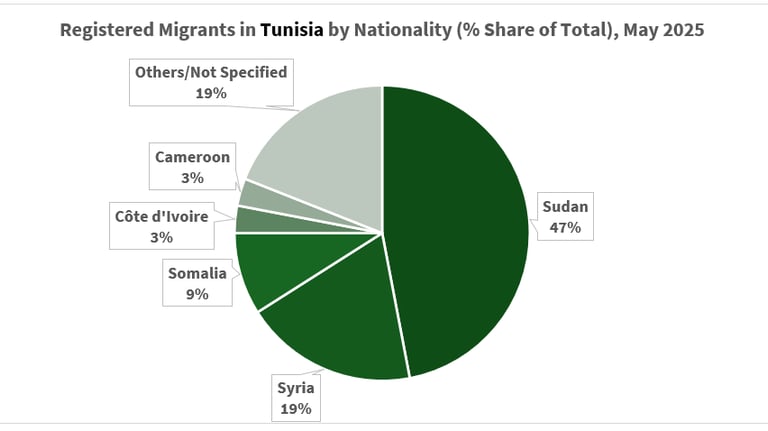Tunisia: Syria and Sudan Dominate Tunisia Migrant Statistics
Key Findings
The United Nations High Commissioner for Refugees (UNHCR) recorded over 10,000 registered migrants by Q1 of 2025.
The top five nationalities were; Sudan (47 percent), Syria (Syria 19 percent), Somalia (9 percent), Côte d'Ivoire (3 percent), and Cameroon (3 percent.) The statistics show that 19 percent of migrants did not have their nationality specifically recorded.
Tunisia is situated very close to Italian and by extension European Union (EU) soil; the port of Sfax is just 188 kilometers (117 miles) from Lampedusa and the Italian island of Pantelleria is just 68 kilometers (42 miles) from Tunisia.
Migrants view Tunisia as an attractive base to launch a journey to Europe from, especially as routes via Turkey and the Balkans become more challenging to migrants.
Conflict in other parts of Africa drives at least some of the flow of migrants, but other factors are also at play.
Download the full report here, or read online below.
Data source: UNHCR. Chart by Orunmila.


Tunisia: Syria and Sudan Dominate Migrant Statistics
Tunisia remains a popular destination for migrants headed to Europe. The country's proximity to Europe, and the tightening of security along other routes, have helped drive this.
Executive Summary
Tunisia has emerged as a significant transit hub for African migrants attempting to reach Europe. Given Tunisia’s geographical proximity to Europe, this is perhaps unsurprising. The port of Sfax lies just 188 kilometers (117 miles) from the Italian island of Lampedusa, European Union soil. In 2024, the Italian island of Pantelleria emerged as a destination, which lies even closer to Tunisia at 68 kilometers from the Tunisian coast. Once on Italian soil, migrants can make their asylum applications. According to the United Nations High Commission for Refugees (UNHCR), as of May 2025, there were over 10,000 migrants registered in Tunisia.(i) Certain nationalities dominate the statistics, with two-thirds coming from just two countries, Syria (5,000) and Sudan (2,036.)
In addition to Syria and Sudan, 19 percent of the UNHCR-recorded migrants came from Somalia (935), Côte d'Ivoire (346), Cameroon (304), Eritrea (221), South Sudan (133), and Guinea (83).(ii) There were also 2,062 (19 percent) migrants from nations not specified in the data, either because they were not specified, or were simply recorded as “Others” by the authorities.
Analysis and Implications
Syrians are looking for new ways out
While the statistics are dominated by sub-Saharan Africans, the fact that Syrians are the biggest nationality is more surprising giving the relative distance between Tunisia and Syria. It could be that as smuggling routes via Turkey/Balkans become harder, Syrians are looking for other routes into Europe.
Sudan’s Civil War
Sudan’s civil war has raged since April 2023. But UNHCR data show that Sudanese have always constituted a large percentage of migrants registered in Tunisia, even before the war began. Between 2020 and 2023, Sudanese migrants account for 26 percent, 7 percent, 34 percent and 25 percent of all migrants respectively. This suggests factors other than conflict was driving Sudanese migration to Tunisia.
Tunisia Remains Attractive Despite EU Migration Deal
The EU and Tunisia have a migration cooperation agreement (EU-Tunisia Memorandum of Understanding), which commits Tunisia to stemming the flow of irregular migrants. Statistics show that Tunisia's geographicaly position continues to make it attractive to those seeking to reach Europe.
Orunmila Research is a consultancy specializing in migration analysis, international affairs, and geopolitical risk. We provide independent, evidence-based, data-driven analysis at the intersection of migration, conflict, and policy. We help governments, NGOs, and institutions understand the deeper, complex drivers behind border movements and instability to allow for a more informed and impactful debate.
Insights
Specializing in migration research.
info@orunmilaresearch.com
© 2025. All rights reserved.
We use AI-generated images for illustration purposes only. To protect the privacy and dignity of migrants, and to comply with local laws in places we operate and research, no photos of real individuals are used. All research and analysis is 100% human-generated.
